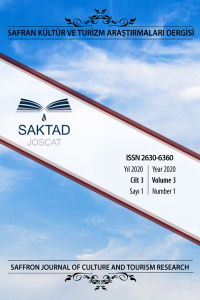Öz
It is also possible to see the animal impacts on art. Animal paintings on cave walls based on nearly forty thousand years hold clues or official documents to catch various cultures lived in that years. Our research aims the pioneer of recent Fables, Physiologus and human animal relationship inspiring it teaching while amusing and educating as well. Human animal relation had huge influence emerging Physiologus both in the west and in east reaching wide mass during medieval times.Physiologus works were called according to the places they were and produced mostly to teach Christian doctrines implying. Allegorical and symbolical meanings were used in Physiologus works. Features of animals in nature were benefitted to make animal meanings and tried to their relation with mankind. This situation brought new additions and some substractions in following years preparing new Physiologus works.
Anahtar Kelimeler
Man and Animal Physiologus Byzantine Painting Art Cultural Studies
Kaynakça
- Referans1 Black, J., Green, A. (1992), Gods, Demons and Symbols of Ancient Mesopotamia: An Illustrated Dictionary, s:70-87 Texas, University of Texas Press. Referans2 Campbell, J. (2016). Batı Mitolojisi Tanrının Maskeleri III. (Çev: Emiroğlu, K.), s:14. İstanbul: Islık Yayınları. Referans3 Capart, J. (1905). Primitive Art in Egypt, s:80-93. London: H.Grevel & Co. Referans4 Cirlot, J.C.(1990). A Dictionary of Symbols Translated from the Spanish by Jack Sage, s: 51-114. London: Routledge. Referans5 Curley, M.J.(2009). Physiologus: A Medieval Book of Nature Lore, s:5. Chicago: T.H.E. University of Chicago Press. Referans6 Dalley, S. (2009). Myths from Mesopotamia: Creation, the Flood, Gilgamesh, and Others (Oxford World's Classics), s:75-90. Oxford: Oxford University Press. Referans7 Faulkner, R., Goelet, O., Andrews, C., Wasserman, J. (2015). The Egyptian Book of the Dead: The Book of Going Forth by Day: The Complete Papyrus of Ani Featuring Integrated Text and Full-Color Images, s:24-56. San Francisco: Chronicle Books. Referans8 Jennison, G.(1937). Animals for Show and Pleasure in Ancient Rome, s:14-52. Philadelphia: Penn Press. Referans9 Klingender, F. D.(1971). Animals in Art and Thought to the End of the Middle Ages, s:238-243. Massachusetts: M.I.T. Press. Referans10 Korhonen, T., Ruonakoski, E.(2017). Human and Animal in Ancient Greece: Empathy and Encounter in Classical Literature, s:28-55. London: I.B.Tauris. Referans11 Lonsdale, S. H. (1979). Attitudes towards Animals in Ancient Greece, Greece & Rome, Cambridge University Press, 26(2), 146-159. Referans12 Mikalson, J. D. (2009). Ancient Greek Religion 2nd Edition, Wiley-Blackwell,s:73-74 Referans13 Pinch, G.(2004). Egyptian Mythology: A Guide To The Gods, Goddesses And Traditions Of Ancient Egypt, s: 45-87. Oxford: Oxford University Press. Referans14 Smith, W. S.(1960). Ancient Egypt Museum of Fine Arts Boston, s:21-60. Boston: T. O. Metcalf Co. Referans15 Seidel, M.(2009). Egyptian Art: The Walters Art Museum, s:18-46. London: D Giles Limited. Referans16 Strzygowski, J.(1899). Der Bilderkreis des griechischen Physiologus, des Cosmas Indikopleustes und Oktateuch nach Handschriften der Bibliothek zu Smyrna Byzantinisches Archiv, s:1-100. Leipzig: B.G Teubner. Referans17 http://www.e-codices.unifr.ch/en/bbb/0318/7v [Erişim Tarihi: 12.12.2019] Referans 18 http://www.bl.uk/catalogues/illuminatedmanuscripts/ILLUMIN.ASP?Size=mid&IllID=16561 [Erişim Tarihi: 15.03.2019] Referans19 http://bestiary.ca/beasts/beast140.htm [Erişim Tarihi: 18.09.2019] Referans20 http://bestiary.ca/beasts/beast232.htm [Erişim Tarihi: 16.02.2020] Referans21 http://bestiary.ca/beasts/beast78.htm [Erişim Tarihi: 17.02.2020] Referans22 https://incil.info [Erişim Tarihi: 14.10.2019] Referans23 https://www.prm.ox.ac.uk/AnimalMummification.html [Erişim Tarihi: 02.11.2019]
Öz
Anahtar Kelimeler
İnsan ve Hayvan Physiologus Bizans Resim Sanatı Kültür Çalışmaları
Kaynakça
- Referans1 Black, J., Green, A. (1992), Gods, Demons and Symbols of Ancient Mesopotamia: An Illustrated Dictionary, s:70-87 Texas, University of Texas Press. Referans2 Campbell, J. (2016). Batı Mitolojisi Tanrının Maskeleri III. (Çev: Emiroğlu, K.), s:14. İstanbul: Islık Yayınları. Referans3 Capart, J. (1905). Primitive Art in Egypt, s:80-93. London: H.Grevel & Co. Referans4 Cirlot, J.C.(1990). A Dictionary of Symbols Translated from the Spanish by Jack Sage, s: 51-114. London: Routledge. Referans5 Curley, M.J.(2009). Physiologus: A Medieval Book of Nature Lore, s:5. Chicago: T.H.E. University of Chicago Press. Referans6 Dalley, S. (2009). Myths from Mesopotamia: Creation, the Flood, Gilgamesh, and Others (Oxford World's Classics), s:75-90. Oxford: Oxford University Press. Referans7 Faulkner, R., Goelet, O., Andrews, C., Wasserman, J. (2015). The Egyptian Book of the Dead: The Book of Going Forth by Day: The Complete Papyrus of Ani Featuring Integrated Text and Full-Color Images, s:24-56. San Francisco: Chronicle Books. Referans8 Jennison, G.(1937). Animals for Show and Pleasure in Ancient Rome, s:14-52. Philadelphia: Penn Press. Referans9 Klingender, F. D.(1971). Animals in Art and Thought to the End of the Middle Ages, s:238-243. Massachusetts: M.I.T. Press. Referans10 Korhonen, T., Ruonakoski, E.(2017). Human and Animal in Ancient Greece: Empathy and Encounter in Classical Literature, s:28-55. London: I.B.Tauris. Referans11 Lonsdale, S. H. (1979). Attitudes towards Animals in Ancient Greece, Greece & Rome, Cambridge University Press, 26(2), 146-159. Referans12 Mikalson, J. D. (2009). Ancient Greek Religion 2nd Edition, Wiley-Blackwell,s:73-74 Referans13 Pinch, G.(2004). Egyptian Mythology: A Guide To The Gods, Goddesses And Traditions Of Ancient Egypt, s: 45-87. Oxford: Oxford University Press. Referans14 Smith, W. S.(1960). Ancient Egypt Museum of Fine Arts Boston, s:21-60. Boston: T. O. Metcalf Co. Referans15 Seidel, M.(2009). Egyptian Art: The Walters Art Museum, s:18-46. London: D Giles Limited. Referans16 Strzygowski, J.(1899). Der Bilderkreis des griechischen Physiologus, des Cosmas Indikopleustes und Oktateuch nach Handschriften der Bibliothek zu Smyrna Byzantinisches Archiv, s:1-100. Leipzig: B.G Teubner. Referans17 http://www.e-codices.unifr.ch/en/bbb/0318/7v [Erişim Tarihi: 12.12.2019] Referans 18 http://www.bl.uk/catalogues/illuminatedmanuscripts/ILLUMIN.ASP?Size=mid&IllID=16561 [Erişim Tarihi: 15.03.2019] Referans19 http://bestiary.ca/beasts/beast140.htm [Erişim Tarihi: 18.09.2019] Referans20 http://bestiary.ca/beasts/beast232.htm [Erişim Tarihi: 16.02.2020] Referans21 http://bestiary.ca/beasts/beast78.htm [Erişim Tarihi: 17.02.2020] Referans22 https://incil.info [Erişim Tarihi: 14.10.2019] Referans23 https://www.prm.ox.ac.uk/AnimalMummification.html [Erişim Tarihi: 02.11.2019]
Ayrıntılar
| Birincil Dil | Türkçe |
|---|---|
| Bölüm | Makaleler |
| Yazarlar | |
| Yayımlanma Tarihi | 30 Nisan 2020 |
| Yayımlandığı Sayı | Yıl 2020 Cilt: 3 Sayı: 1 |


